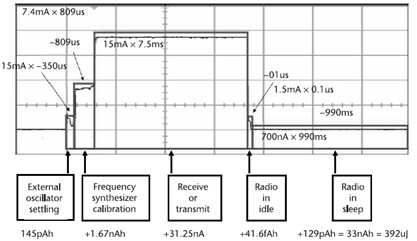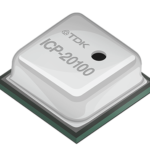In a battery-powered, wireless sensing node, the biggest energy consumer typically is the RF transmitter. The transceiver should have extremely low power in active, wait and even sleep modes. A one-second snapshot of the current consumption in the various portions of the transmission cycle shows the current draw of 15 mA for the 7.5-ms receive or transmit portion versus 700 nA for the radio in sleep mode and comprises over 90% of the total 33-nAh (392-μJ) energy consumption. This is just one example of minimizing the current draw to transmit or receive sensor data.
 Example of current draws and duration in the transmission cycle.
Example of current draws and duration in the transmission cycle.
Maximizing the amount of sleep time is essential for other portions of the sensor node as well. Since the available energy must power all portions of the system and the energy budget is limited, the power consumption of the sensor or sensors in a wireless node need to be considered, too. While it is increasingly important, low power has not always been a critical parameter for many sensors. An interesting example is a resistive sensor that normally draws a substantial amount of current in an analog measurement.
Typically, a Wheatstone bridge used in applications such as pressure, force and weight measurements would have a 350Ω strain gauge but this could be increased to 1 K-Ω or more to reduce the current draw. If the bridge is not turned off, a 1 K-Ω bridge with 3V applied draws 3 mA continuously. If the bridge is switched on to make a reading and then off, it can still have the current on for a relatively long time to stabilize the reading.
An alternative technique uses a time to digital converter (TDC) instead of an analog measurement. The measurement is made in the time domain by combining the resistors of the bridge with a capacitor and only energizing the strain gauge for about 100 μS. This approach saves power and minimizes self-heating effects. Other approaches that address minimizing power consumption may allow the use of a sensing technique that would otherwise be deemed unacceptable for a wireless sensor application.
If the power consumption is a major concern, the common power consumption for different sensor types should be a starting point before looking for the lowest power consumption sensor for a specific sensor node. Table 1 shows some readily available values for popular sensing applications.
Table 1. Power consumption for different types of sensors.
Sensor Type Power Consumption
Gas sensor 500mW-800mW
Image sensor 150mW
Acceleration sensor 3mW
Temperature sensor 0.5mW-5mW
Many MEMS sensors use capacitive sensing and draw minimum power. However, for Always On applications, such as fitness trackers, wearables and other products that require extremely low power consumption, sensor designers are providing users even lower power consumption products. While a digital capacitive pressure sensor could draw over a milliamp during conversion, at supply voltages in 1.5 to 3.6 V range some sensors can draw <0.1 µA in standby. Depending on the oversampling rate (OSR), the supply current and the ADC conversion time can each increase by a factor of 25 times or more, so minimal rates should be used.
References
Understanding Smart Sensors, 3rd Edition, Chapter 15


